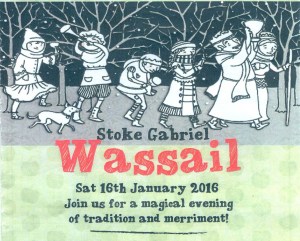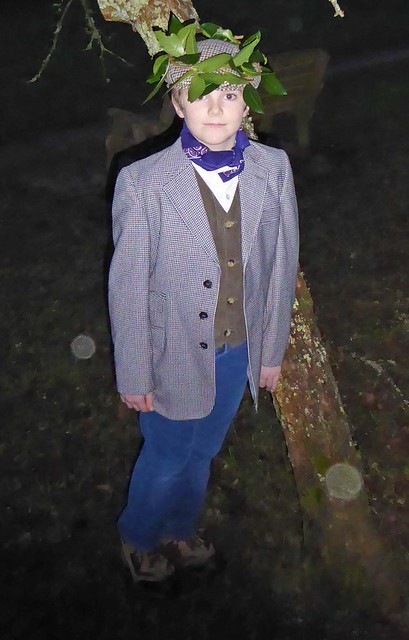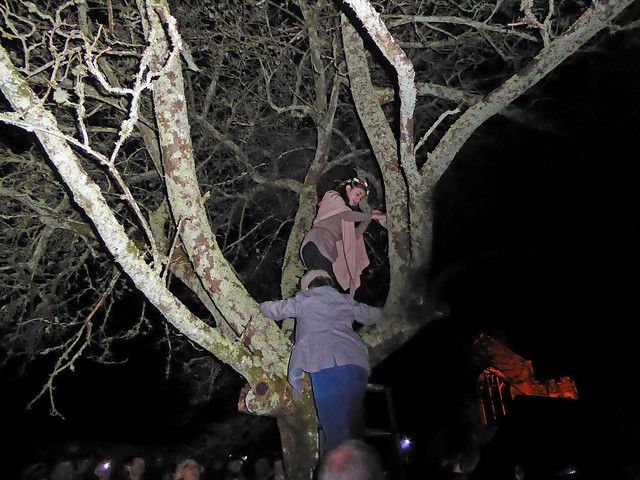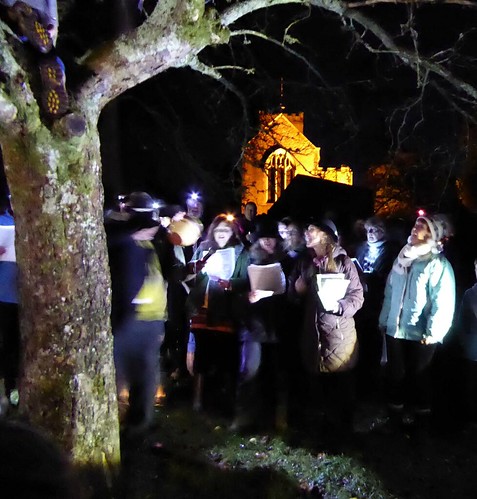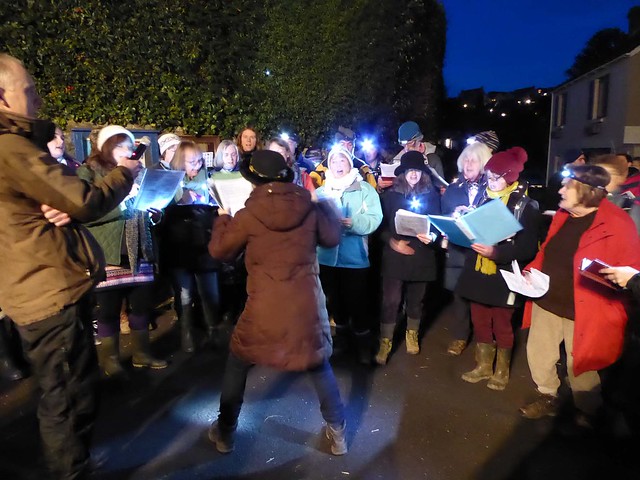Midwinter fire ceremonies were once very popular in the UK, especially in rural communities. People gathered around the hearth in a noisy, joyous celebration, with the fire bringing light into the darkness of winter. These ceremonies probably have a pagan origin and one which used to be widespread in the UK was Burning the Yule Log. Less well known but quite common in Devon and neighbouring parts of Dorset and Somerset in the west of the UK was Burning the Ashen Faggot. Although it has now largely disappeared as a household custom, it is still celebrated in a handful of local pubs to the accompaniment of hearty singing and copious drinking.

The ashen faggot was a large bundle of ash sticks or an ash log surrounded by smaller sticks, all bound together by thin bands of willow or hazel (withies). The ashen faggot was cut and constructed on Christmas Eve and placed on a fire kindled with remnants of last year’s faggot. Ash burns well, even when green and as the fire caught and each of the withies broke, tradition demanded that a new jug of cider be brought out to quench the thirst of the assembled company.
The scene around the hearth as the Faggot burned is vividly brought to life in this extract from Festivities and Superstitions of Devonshire in Bentley’s Miscellany 1847:
“On Christmas Eve it is the custom in all the farm houses of this neighbourhood to “burn the ashen faggot”. All the labourers and servants are invited, and a huge fire is heaped up on the wide hearth. We all sat round the hearth in a circle; the firelight deepening the shadows on the hard-featured mahogany countenances around, and setting off the peculiarities of each form. The ashen faggot which lay on the hearth consists of a long immense log of ash, surrounded with smaller branches bound to it with many withies, forming one large bundle; it filled the whole hearth and as it burned the roaring in the large chimney was tremendous. As the fire slowly catches and consumes the withies, the sticks fly off and kindle into a sudden blaze and as each one after the other gives way, all present stand up and shout with might and main; the “loving cup” of cider is handed round and each drinks his fill. They then resume their seats, sing songs, crack jokes until the bursting of another band and the kindling of a fresh blaze demands renewed shouts and another pull at the cider flagon. The merriment is allowed to go on till nearly midnight, before which hour the worthy giver of the feast likes to have her house clear, that the “Holy Day” may begin in peace. This custom is kept up religiously in all the farmhouses around, and is one of the principal festivals of the year.”
Burning the Ashen Faggot was a very popular west country custom and Amery, writing in the Transactions of the Devonshire Association (1879), reported that in the Ashburton postal district alone 32 farms and cottages burnt the Ashen Faggot on Christmas Eve 1878. There were various superstitions and beliefs associated with the event and an old man present at one of the 1878 ceremonies told how the custom “commemorated the first dressing of our Saviour in swaddling clothes, because Joseph cut a faggot of ash, which is well known to burn green and lighted a fire by which the child was first dressed”. The custom was also widespread in 19th and early 20th century Somerset where it was often combined with apple tree wassailing and held on old Christmas Eve (January 5th ). There is one 19th century record of burning the Ashen Faggot in East Devon for Christmas Eve 1839 at Bindon Farm about 4 miles from the Devon/Dorset Border.
In the 19th century, the Ashen Faggot was a household custom bringing working people together at Christmas. Servants and farm labourers and their families were all invited to the farmhouse with its huge hearth and the celebration was provided by the farmer and his wife in thanks for the year’s work. For one evening at least, people put aside divisions and squabbles. The custom began to die out as work patterns changed, as the railways enabled people to move about and as artificial light banished winter darkness.

It seems likely that the custom would have disappeared altogether had it not been taken on by local pubs where it still survives despite recent closures and more stringent insurance requirements. One pub where it flourishes is the 800-year-old Harbour Inn at Axmouth in East Devon and I spoke to one of the villagers, Nigel Daniel, who helps organise the annual ceremony. He told me that on Christmas Eve morning a group of villagers cut the ash and make the faggot which measures about six feet in length and five feet in circumference, filling the expanse of the old inglenook fireplace. Seven bindings each made from hazel are used to secure the faggot which is traditionally taken to the Harbour Inn at lunchtime where a few early Christmas drinks are enjoyed.

The ceremony itself starts late Christmas Eve with the reading of the following lines taken from Christmas by RJ Thorn 1795:
Thy welcome eve, loved Christmas now arrived,
The parish bells, their tuneful peals resound,
And mirth and gladness every breast pervade,
The ponderous Ashen Faggot, from the yard,
The jolly farmer to his crowded hall conveys with speed;
where, on the rising flames, it blazes soon.
Seven bandages it bears,
and as they each disjoin, a mighty jug of sparkling cider’s brought
with brandy mixed to elevate the guests!
The Ashen Faggot is placed upon the open hearth where it soon lights with its distinctive orange and purple flames. As each binding “disjoins” revellers are urged to recharge their glasses accompanied with seasonal toasts. Local singers Ian Hunt and Phil Gamble perform three Seasonal songs: The King, Christmas Song (from the Copper family) and Stormy Winds. Communal carol singing follows continuing well into the night.

The ceremony at the Harbour Inn was revived more than 70 years ago by the landlord Ludovic Grant who used to present a roasted boar’s head as part of the celebrations. The BBC showed interest in the ceremony in the 1950s, broadcasting it on radio and television, but when Ludovic Grant retired in the late 1950s it sadly lapsed. Fortunately, Axmouth thatcher, David Trezise and local gardener, Ned Spiller got together in the early 1970s to restart the ceremony and, led for many years by David Trezise, and with the enthusiastic support of subsequent landlords the event has flourished at the Harbour Inn offering a truly traditional start to a modern Christmas.
The ceremony will be held again this Christmas Eve at the Harbour Inn, Axmouth, but you can also step back in time and participate in this ancient west country custom at the Luttrell Arms in Dunster on December 24th and at the Squirrel Inn at Laymore near Chard and the Digby Tap in Sherborne on January 6th, but please check the timing.
I should like to thank Nigel Daniel for generous help in preparing this article and for providing photographs, also Kristy of the Harbour Inn and Tiffany Hyde for generously providing photos.


This article appeared in the December 2019 edition of the Marshwood Vale Magazine.
The picture at the head of this post shows the Ashen Faggot burning on the hearth at the Harbour Inn, Axmouth on Christmas Eve while carols are sung, courtesy of Kristy of the Harbour Inn.



